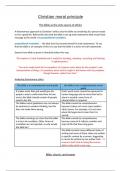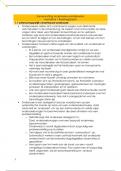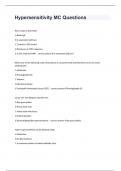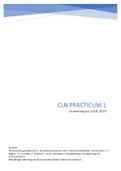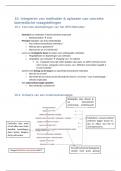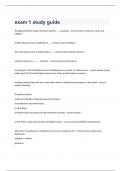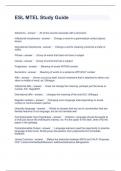Nutritional physiology HAP30306 2021 summary lectures + slides
Week 1: digestive system
Lecture 1: Mass flow of nutrients (through the body and its cells)
Why does the digestive system not digest itself?
- Activity restricted to presence of food
- Regulation (local, distal, proximal)
- Enzymes stored as inactive pro-enzymes (zymogens)
- Non-digestible mucus coats the wall
- High replacement rate (turnover) of mucosal cells
Meal feeding ~ metabolic changes
Post prandial phase: digestion-absorption-storage
Input > needs -> anabolic or catabolic disposal
(Storage, interconversion, oxidation)
Post absorptive phase: utilization
Input < needs -> mobilization
(Turnover, interconversion, oxidation)
Thermogenic effects of a meal: diet-induced thermogenesis (DIT)
- Post prandial metabolism (PPM) increases heat production (5-20% ingested ME)
- Effects depend on ingested nutrients: proteins > carbohydrates > fat
- Ingested ME is not corrected for energetic costs of PPM
Homeostasis: ability of an organism to counteract (within limits of the metabolic scope)
factors that disturb vital functions
- Glucose concentration in the blood
- pH in the blood (acid-base balance)
- oxygen supply (CO, respiration)
- body temperature (thermoregulation)
4 layers GI-tract: inside (lumen) to outside
- mucosa: secretion and absorption
- submucosa: vascular layer (support)
Meissner plexus (muscular mucosa)
- muscularis: segmental contractions
circular / longitudinal layers
Auerbach’s plexus
- serosa: protective layer
Digestive system – CNS
Gut stimuli evoke digestive responses via the enteric and the central nervous systems.
1
,GI-tract – communication
1. endocrine: via circulation (blood), hormones – e.g. gastrin
2. neurocrine: via neurons (CNS) releasing messengers, neurotransmitters – e.g. GRP,
Acetylcholine
3. paracrine: local cell-to-cell communication – e.g. somatostatin
Digestive system – motor behaviour
- Segmentation by circular muscles
- The regulation of peristalsis requires neural reflexes
Absorption
- Simple diffusion: water and small lipids – cross into intestinal cells freely
- Facilitated diffusion: water-soluble vitamins – need a specific carrier to transport
them from one side of the cell membrane to the other.
- Active transport: glucose and amino acids – move against a concentration gradient,
which requires energy
Digestive, interdigestive state MMC (Migrating Motor Complex)
During the interdigestive state there are periodic bursts of organ responses
MMC (humans)
- Phase 1: 40 mins rest
- Phase 2: 40 min start peristalsis
- Phase 3: 10 min Max. peristalsis
- Prevention of bacterial stasis
- Final cleaning non-digestible parts
Transit time in humans
- Stomach 1 – 5 hours
- Small intestine 1.5 hours
- Large intestine 1 – 2 days
Integrated response to a meal = mass flow of nutrients * regulation
Lecture 2 Anticipation to a meal: Cephalic / oral / Gastric phase
The cephalic phase
- The vagus effects the gastrointestinal response during the cephalic phase
o DVC: dorsal vagal complex
- Anticipation, sight, smell of food
- Taste is not part of the cephalic phase
- Secretory behavior: HCl, pepsinogen, intrinsic factor, gastrin, enzymes
- Effector responses during the cephalic phase and oral phases mediated by the
parasympathetic nervous system
Stimulus Transmission pathway Effector response
Auditory, Higher brain centers -> DVC Salivary secretion, gastric
Cognitive, -> increase parasympathetic secretion, pancreatic
Visual, outflow (via vagus nerve) enzyme secretion,
Olfactory gallbladder contraction,
relaxation of the sphincter
of Oddi
2
, - Cephalic phase gastric acid secretory responses are meal
dependent
- Gastric secretion during the cephalic phase prepares
stomach for digestion
- Gastric acid secretion occurs in three phases during the
response to a meal
- Regulation of energy intake involves integration of short and
long term signals from many sources
The oral phase
- The oral cavity prepares food for transfer to the pharynx and activates the digestive
process
- Salivary amylase activity is maintained in the stomach by buffers and substrate
protection
- The pharynx and esophagus move the food blokes to the stomach
- Neurotransmitters mediate swallow-induced esophageal peristalsis and les (lower
esophageal sphincter) relaxation
- Swallowing initiates pharyngeal and esophageal peristalsis and sphincter relaxation
- Swallowing induces relaxation of les and proximal stomach
The gastric phase
Food enters the stomach
- Divided into three regions
- Gastric distension triggers responses mediated by vago-
vagal reflexes
- Receptive relaxation in the proximal stomach is
dependent on the vagus nerve
- Both vago-vagal reflex and endocrine release of gastrin stimulate acid and
pepsinogen secretion during the gastric phase
Gastric pH
- Gastric pH = 2
- Ingested proteins are denatured (secondary and tertiary structure)
- Pepsinogen activated to pepsin (H+)
- pH optimum for pepsin
- pepsin starts digestion of proteins (primary structure)
Pepsin
- pepsinogen -> pepsin
- endopeptidase: non-terminal amino acids
- specific for aromatic amino acids, leucine, and methionine
- partial digestion of dietary proteins to oligopeptides with these amino acids at the
carboxyl end
- oligopeptides maintain gastrin secretion
(gastric cells table z.o.z.)
3
, Gastric cells:
Cell type Product Function
Surface cells, neck cells Mucus, HCO-3, Trefoil Lubrication, protection
peptides
Parietal cells H+, intrinsic factor Protein digestion, binding of
cobalamin (vit. B12)
Chief cells Pepsinogen, gastric lipase Protein digestion,
triglyceride digestion
Endocrine cells Gastrin, histamine, Regulation of acid secretion
somatostatin
- cobalamin (vit.B12) absorption and storage depends on several organs
- vagal activation stimulates multiple cell responses via neurotransmitters
Gastric parietal cell activation
- acetylcholine, gastrin, and histamine stimulate the parietal cell
- each parietal cell secretagogue binds to its own receptor and interacts with the
others
- ionic concentrations in gastric juice vary with secretory rate
Feedback via somatostatin
- acid in the antrum stimulates somatostatin release to inhibit
meal-stimulated gastrin secretion
- the stomach alters the physical and chemical characteristics of
the meal
- gastric mixing and triglyceride digestion liberate free fatty acids
which are potent stimulants of CCK release
Gastric Motor Response
- a meal initiates three gastric motor responses during the gastric phase
1. receptive relaxation: of the fundus and body to accommodate the volume of the
meal
2. mixing and grinding: antral peristalsis to grind the meal into small particles and mix
with secretions
3. emptying: coordination of antro-pyloro-duodenal motor activity for regulation of
gastric emptying. In addition, the reservoir function participates in emptying by
regulation of fundus tone.
Gastric emptying
- digestive phase: duodenal cluster unit
o particle size: < 2 mm; osmolarity: mainly hyperosmotic; energy: ~ 8.5kJ/min
- interdigestive phase: MMC-complex
- duodenal contents initiate signals that delay gastric emptying
Lecture 3 I Duodenal cluster unit; II Jejunum, Ileum, and colon
Duodenal cluster unit
- contains: duodenum, stomach, biliary system, exocrine pancreas
not liver
- regulates entry of chyme, titrates exocrine secretions and mixes them.
4
Week 1: digestive system
Lecture 1: Mass flow of nutrients (through the body and its cells)
Why does the digestive system not digest itself?
- Activity restricted to presence of food
- Regulation (local, distal, proximal)
- Enzymes stored as inactive pro-enzymes (zymogens)
- Non-digestible mucus coats the wall
- High replacement rate (turnover) of mucosal cells
Meal feeding ~ metabolic changes
Post prandial phase: digestion-absorption-storage
Input > needs -> anabolic or catabolic disposal
(Storage, interconversion, oxidation)
Post absorptive phase: utilization
Input < needs -> mobilization
(Turnover, interconversion, oxidation)
Thermogenic effects of a meal: diet-induced thermogenesis (DIT)
- Post prandial metabolism (PPM) increases heat production (5-20% ingested ME)
- Effects depend on ingested nutrients: proteins > carbohydrates > fat
- Ingested ME is not corrected for energetic costs of PPM
Homeostasis: ability of an organism to counteract (within limits of the metabolic scope)
factors that disturb vital functions
- Glucose concentration in the blood
- pH in the blood (acid-base balance)
- oxygen supply (CO, respiration)
- body temperature (thermoregulation)
4 layers GI-tract: inside (lumen) to outside
- mucosa: secretion and absorption
- submucosa: vascular layer (support)
Meissner plexus (muscular mucosa)
- muscularis: segmental contractions
circular / longitudinal layers
Auerbach’s plexus
- serosa: protective layer
Digestive system – CNS
Gut stimuli evoke digestive responses via the enteric and the central nervous systems.
1
,GI-tract – communication
1. endocrine: via circulation (blood), hormones – e.g. gastrin
2. neurocrine: via neurons (CNS) releasing messengers, neurotransmitters – e.g. GRP,
Acetylcholine
3. paracrine: local cell-to-cell communication – e.g. somatostatin
Digestive system – motor behaviour
- Segmentation by circular muscles
- The regulation of peristalsis requires neural reflexes
Absorption
- Simple diffusion: water and small lipids – cross into intestinal cells freely
- Facilitated diffusion: water-soluble vitamins – need a specific carrier to transport
them from one side of the cell membrane to the other.
- Active transport: glucose and amino acids – move against a concentration gradient,
which requires energy
Digestive, interdigestive state MMC (Migrating Motor Complex)
During the interdigestive state there are periodic bursts of organ responses
MMC (humans)
- Phase 1: 40 mins rest
- Phase 2: 40 min start peristalsis
- Phase 3: 10 min Max. peristalsis
- Prevention of bacterial stasis
- Final cleaning non-digestible parts
Transit time in humans
- Stomach 1 – 5 hours
- Small intestine 1.5 hours
- Large intestine 1 – 2 days
Integrated response to a meal = mass flow of nutrients * regulation
Lecture 2 Anticipation to a meal: Cephalic / oral / Gastric phase
The cephalic phase
- The vagus effects the gastrointestinal response during the cephalic phase
o DVC: dorsal vagal complex
- Anticipation, sight, smell of food
- Taste is not part of the cephalic phase
- Secretory behavior: HCl, pepsinogen, intrinsic factor, gastrin, enzymes
- Effector responses during the cephalic phase and oral phases mediated by the
parasympathetic nervous system
Stimulus Transmission pathway Effector response
Auditory, Higher brain centers -> DVC Salivary secretion, gastric
Cognitive, -> increase parasympathetic secretion, pancreatic
Visual, outflow (via vagus nerve) enzyme secretion,
Olfactory gallbladder contraction,
relaxation of the sphincter
of Oddi
2
, - Cephalic phase gastric acid secretory responses are meal
dependent
- Gastric secretion during the cephalic phase prepares
stomach for digestion
- Gastric acid secretion occurs in three phases during the
response to a meal
- Regulation of energy intake involves integration of short and
long term signals from many sources
The oral phase
- The oral cavity prepares food for transfer to the pharynx and activates the digestive
process
- Salivary amylase activity is maintained in the stomach by buffers and substrate
protection
- The pharynx and esophagus move the food blokes to the stomach
- Neurotransmitters mediate swallow-induced esophageal peristalsis and les (lower
esophageal sphincter) relaxation
- Swallowing initiates pharyngeal and esophageal peristalsis and sphincter relaxation
- Swallowing induces relaxation of les and proximal stomach
The gastric phase
Food enters the stomach
- Divided into three regions
- Gastric distension triggers responses mediated by vago-
vagal reflexes
- Receptive relaxation in the proximal stomach is
dependent on the vagus nerve
- Both vago-vagal reflex and endocrine release of gastrin stimulate acid and
pepsinogen secretion during the gastric phase
Gastric pH
- Gastric pH = 2
- Ingested proteins are denatured (secondary and tertiary structure)
- Pepsinogen activated to pepsin (H+)
- pH optimum for pepsin
- pepsin starts digestion of proteins (primary structure)
Pepsin
- pepsinogen -> pepsin
- endopeptidase: non-terminal amino acids
- specific for aromatic amino acids, leucine, and methionine
- partial digestion of dietary proteins to oligopeptides with these amino acids at the
carboxyl end
- oligopeptides maintain gastrin secretion
(gastric cells table z.o.z.)
3
, Gastric cells:
Cell type Product Function
Surface cells, neck cells Mucus, HCO-3, Trefoil Lubrication, protection
peptides
Parietal cells H+, intrinsic factor Protein digestion, binding of
cobalamin (vit. B12)
Chief cells Pepsinogen, gastric lipase Protein digestion,
triglyceride digestion
Endocrine cells Gastrin, histamine, Regulation of acid secretion
somatostatin
- cobalamin (vit.B12) absorption and storage depends on several organs
- vagal activation stimulates multiple cell responses via neurotransmitters
Gastric parietal cell activation
- acetylcholine, gastrin, and histamine stimulate the parietal cell
- each parietal cell secretagogue binds to its own receptor and interacts with the
others
- ionic concentrations in gastric juice vary with secretory rate
Feedback via somatostatin
- acid in the antrum stimulates somatostatin release to inhibit
meal-stimulated gastrin secretion
- the stomach alters the physical and chemical characteristics of
the meal
- gastric mixing and triglyceride digestion liberate free fatty acids
which are potent stimulants of CCK release
Gastric Motor Response
- a meal initiates three gastric motor responses during the gastric phase
1. receptive relaxation: of the fundus and body to accommodate the volume of the
meal
2. mixing and grinding: antral peristalsis to grind the meal into small particles and mix
with secretions
3. emptying: coordination of antro-pyloro-duodenal motor activity for regulation of
gastric emptying. In addition, the reservoir function participates in emptying by
regulation of fundus tone.
Gastric emptying
- digestive phase: duodenal cluster unit
o particle size: < 2 mm; osmolarity: mainly hyperosmotic; energy: ~ 8.5kJ/min
- interdigestive phase: MMC-complex
- duodenal contents initiate signals that delay gastric emptying
Lecture 3 I Duodenal cluster unit; II Jejunum, Ileum, and colon
Duodenal cluster unit
- contains: duodenum, stomach, biliary system, exocrine pancreas
not liver
- regulates entry of chyme, titrates exocrine secretions and mixes them.
4


